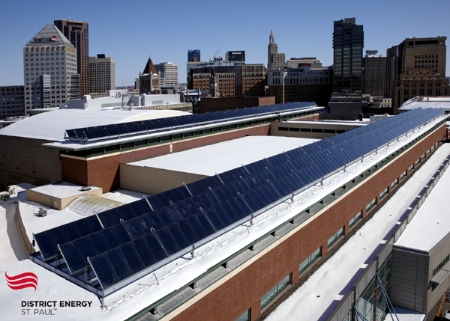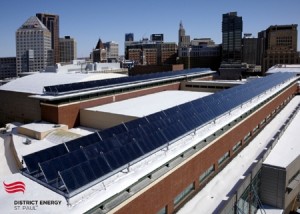If you live in the Midwest, and if you are a solar energy aficionado, you have had great reason to be jealous of most, if not all, of the rest of the country. The great states of Florida, California, Arizona, Texas, Oregon, New Jersey, Massachusetts, and North Carolina have all received headlines of leading-edge technology, especially in the commercial solar hot water space.
In this unobtrusive mid-country, which is frozen stiff for at least six months of the year, a new model and implementation of commercial solar hot water has been successfully completed. In downtown St. Paul, Minn., there is a new solar hot water heating plant that is now producing a large share of the heating for the city’s Saint Paul RiverCentre convention center. The RiverCentre offers 162,000-plus square feet of convention and ballroom space, and is connected to the Xcel Energy Center, situated on a six-acre adjoining site encompassing another 650,000 square feet of open territory.

This newest of commercial-grade solar technology was created by the local utility, District Energy St. Paul, a non-profit corporation that was founded through a public-private partnership with the City of St. Paul, the St. Paul Building Owners and Managers Association and the State of Minnesota, among others. Its initial and continuing purpose is to provide an efficient and centralized hot water district heating system to serve downtown St. Paul and surrounding areas. Those spaces encompass commercial buildings, condominiums, hotels, sports facilities, universities, government complexes, and other public facilities. Currently, more than 187 buildings (31.7 million square feet), and 300 townhomes in the downtown St. Paul area, including the Capitol Complex and proximate office and residential space, are being served by the District Energy St. Paul systems.
By relying on the economies of scale available by providing a central heating and cooling plant to high building density areas, organizations such as District Energy St. Paul can provide more efficient, economical, and environmentally friendly plant systems. In addition to its newest and most efficient solar hot water system, District Energy St. Paul has been utilizing biomass fuels as its energy source for a number of years, and it is also including biogas and heat recovery in its overall project plans for the city.
So, just how “grand” is this commercial solar hot water system?
The system begins with solar collectors on the roof of the St. Paul RiverCentre. There are 144 such collectors in two arrays. Each collector is 8-by-20 feet in size – that’s 23,040 square feet of solar collectors. The system is designed to produce 1 megawatt of solar hot water power. So far the system has hit as high as 1.2 MW. Once the energy is collected on the roof it is channeled through a series of highly insulated conduits an approximate distance of a few hundred feet to where the balance of system is located in the lower levels of the RiverCentre. The BOS includes the piping, holding tanks, pumps, valves, gauges, expansion tanks, controls, data loggers and monitoring systems.
When the demand requires more hot water for heating the building, the system switches to provide more of its generated heat (hot water) to meet that call. When there are events at the RiverCentre and the building needs more hot potable (drinkable/sanitary) water for cleaning, dishwashing, etc., the solar system switches its output (or a portion of it) to meet that need.
During times when the building doesn’t need any hot water (i.e. in the summer time when there are fewer events and heating needs decline) the solar system switches its output to the other buildings in the District Energy system. Remember, there are more than 180 other buildings in their system, and those are both commercial and residential. Such an array of buildings in one system will always have a need for hot water, 24/7. This has been one of the “over-production problems” of solar hot water in the past. When a solar hot water system produces more energy than is needed, that extra heat has to be “vented” or cast-off in some manner. For homes and hotels, that heat has been used to heat swimming pools and hot tubs; but not all buildings, especially residential buildings, have these extra features. The District Energy of St. Paul system uses all that excess heat energy. With time, as their budget allows, maybe they will also look at how solar hot water systems can provide air conditioning, chilling, and dehumidification.
One of the key benefits of this system, in my opinion, is its ability to provide our industry the missing data we have needed for so long. The performance data, which is being keenly collected and analyzed by the system’s project engineer, will provide us with the one piece of the puzzle that has been holding back commercial solar hot water in the region, not to mention most of the country. So far, the problem has been this:
We know solar hot water works. Not only does it work, it is far more efficient and cost effective than solar photovoltaics, and therefore, far more efficient, cost effective, and environmentally safer than all fossil-based energy sources. There is no argument there.
The question has always been, “How much more efficient and cost effective?” This is the hurdle that the commercial real estate industry has wanted to know, and rightfully so. The developers, property owners, property managers, engineers, designers, architects, planners, city developers have all been sitting on the sidelines, waiting for the answers and the solar hot water industry has not been able to provide them.
Europeans have the answers. They have been implementing systems for many years; however, they are half way around the globe from us, and that renders their data unusable here. Now that we have this facility, with its remarkably capable data logging and performance calculating systems, we can finally provide professionals with the answers they need to go ahead with recommending and implementing commercial scale solar hot water systems in the region and across the country.

 Follow
Follow